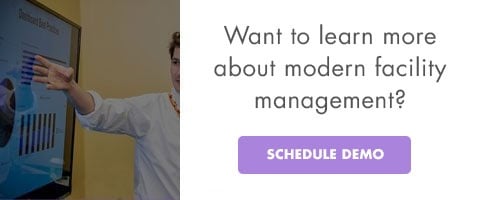The Evolution of Facilities Management


There are plenty of professions where the basic responsibilities of the role remain essentially the same throughout someone’s career.
Facilities management is not one of them.
Thanks to technology that is constantly increasing in functionality and the ever-growing expectations of the workforce, facilities management looks nothing like it did even 10 years ago.
In order to be successful as a modern facilities manager (FM), you must understand how the role has been defined in the past, what it looks like today and what it’s likely to look like in the future.
What Facilities Management Used to Mean
The best way to think about how facilities management has evolved is to focus on the “management” aspect. When the role first emerged in the 1970s, the title of facilities manager was taken quite literally. The primary concern of an FM was to maintain and increase the efficiency of the workplace by performing and supervising on-demand and preventative maintenance.
Over the next two decades, the definition of facilities management grew to encompass more than just the brick-and-mortar aspect of the company. FMs became responsible for the components that make up the workplace—i.e., assets, tools/technology and personnel. Their obligations also expanded to general property management as well as overseeing leases and contracts.
In the 2000s, facilities management broadened to include duties associated with business operations. For example, FMs were now tasked with activities related to human resources and payroll. In other words, the scope of the position was changing—and quickly.
Still, facilities management has traditionally been a job people almost fell into. They may have started as a groundskeeper or maintenance professional and worked their way up to a management position as their job expanded. In many cases, formal training has been rare; facilities managers learned primarily through on-the-job experiences.
Facilities management is a demanding profession that requires a diverse set of skills in order to be successful. The consistent professional, interpersonal and even emotional demands that FMs face on a daily basis seem to fly from all directions.
What Facilities Management Means Now
A big breakthrough for the industry came this year, when the Bureau of Labor Statistics announced they would finally recognize facilities managers with a Standard Occupational Classification code, according to Facility Executive.
The International Facility Management Association (IFMA) had been pushing for it for years.
In a previous statement published in the article, the IFMA underscored the importance of this designation.
“A stand-alone BLS SOC designation not only reflects the reality of the occupational landscape, it is a critical component of attracting appropriate talent to the profession to fill the labor gap,” the IFMA stated. “When educational institutions—from secondary school guidance counselors to post-secondary educators—consider vocation-based curricula, they often look first to the BLS SOC for relevant data. If facility management is not found as a separate occupation, they dismiss the need to train students to pursue the profession.”
Facilities management professionals entering the field now and in the years to come will likely see more formal training opportunities. Some colleges and universities, including Temple University, have a four-year facilities management degree program, while others have certificates available. As the career becomes more clearly defined, employers will come to expect facilities managers to have a more standard set of competencies.
In our eBook, 8 New Facilities Management Metrics You Need to Know, we discussed the findings of IFMA’s 2009 Global Job Task Analysis (GJTA), which lists 11 core competencies of modern-day facilities management:
- Emergency Preparedness and Business Continuity
- Environmental Stewardship and Sustainability
- Real Estate and Property Management
- Operations and Maintenance
- Leadership and Strategy
- Finance and Business
- Project Management
- Quality Control
- Communication
- Human Factors
- Technology
Clearly, the role of FM has grown considerably. And today’s FMs have a hand in nearly every aspect of a business.
What makes it possible for a modern FM to tackle eachso of these initiatives is the ability to collect and analyze data and then use that data to develop workplace management strategies. These required facility management skills have also led to the evolution of the title of “facilities manager.”
For example, it’s not uncommon to now see titles such as:
- Facilities Strategist
- Facilities System Specialist
- Facility Maintenance Analyst
- Space & Facility Management Specialist
- Space Planning & Logistics Leader
- Workplace Strategist
Where Facilities Management is Headed
The modern workplace is agile and flexible. It’s driven by technology and connectivity. In order to succeed in facilities management today, you have to be able to make data-driven decisions based on these factors. You must support the mobility and freedom of the workforce by providing the facility management tools, technologies and workspaces that empower employees to thrive.
To continue positively impacting the business, you must recognize the power you have over employee engagement, employee satisfaction and, most importantly, the employee experience.
The employee experience is primarily influenced by three things:
- The physical workspace
- The technologies and tools employees are given
- What an employer does (or doesn’t do) to prove its commitment to the health of its workforce.
And you have extensive authority over all three of these elements.
Your approach to each directly impacts recruiting and retention, productivity and the future of the business itself. Not only that, your approach directly impacts the future of your career.
No matter what your job title, if you’re involved in facilities management, it’s imperative for you to embrace not only the past and current evolution of your position but also to understand what will define the role going forward.
You must embrace how the position of facilities manager has transformed from being a service provider to being a strategic partner, analyst and support system for both the workplace and the workforce.
Editor’s Note: This blog post was originally published in July 2018 and has been updated for accuracy and relevance.



